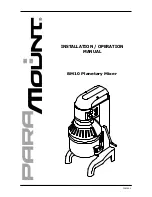
63
This Glossary contains brief definitions of
many of the audio and electronic terms used in
discussions of sound mixing and recording. Many
of the terms have other meanings or nuances or
very rigorous technical definitions which we have
sidestepped here because we figure you already
have a lot on your mind. If you’d like to get more
information, you can call Mix Bookshelf at
1-800-233-9604. We recommend the following
titles:
The Audio Dictionary
, by Glenn White;
Tech Terms
, by Peterson & Oppenheimer;
Handbook for Sound Engineers
, by Glen Ballou,
Mackie Mixer Book
by Rudy Trubitt and
Sound
Reinforcement Handbook
, by Gary Davis.
AFL
An acronym for After Fade Listen, which is
another way of saying post-fader solo function.
assign
In sound mixers,
assign
means to switch or
route a signal to a particular signal path or
combination of signal paths.
attenuate
To reduce or make quieter.
aux
See next entry.
auxiliary
In sound mixers, supplemental equipment
or features that provide additional capabilities
to the basic system. Examples of auxiliary
equipment include: serial processors (equaliz-
ers, compressors, limiters, gates) and parallel
devices (reverberation and delay). Most mix-
ers have aux send buses and aux return inputs
to accommodate auxiliary equipment.
balanced
In a classic balanced audio circuit, the two
legs of the circuit (+ and –) are isolated from
the circuit ground by exactly the same imped-
ance. Additionally, each leg may carry the signal
at exactly the same level but with opposite po-
larity with respect to ground. In some balanced
circuits, only one leg actually carries the signal
but both legs exhibit the same impedance char-
acteristics with respect to ground. Balanced
input circuits can offer excellent rejection of
common-mode noise induced into the line and
also make proper (no ground loops) system
grounding easier. Usually terminated with
1
⁄
4
"
TRS or XLR connectors.
bandwidth
The band of frequencies that pass through a
device with a loss of less than 3dB, expressed
in Hertz or in musical octaves. Also see
Q
.
bus
An electrical connection common to three
or more circuits. In mixer design, a bus usually
carries signals from a number of inputs to a
mixing amplifier, just like a city bus carries
people from a number of neighborhoods to
their jobs.
Cannon
A manufacturer of electrical connectors
who first popularized the three-pin connector
now used universally for balanced microphone
connections. In sound work, a Cannon connec-
tor is taken to mean a Cannon XLR-3 mic
connector or any compatible connector.
cardioid
Means heart-shaped. In sound work, car-
dioid refers to the shape of the sensitivity
pattern of some directional microphones.
channel
A functional path in an audio circuit: an
input channel, an output channel, a recording
channel, the left channel and so on.
channel strip
The physical representation of an audio
channel on the front panel of a mixer; usually
a long, vertical strip of controls.
chorusing
An effect available in some digital delay
effects units and reverbs. Chorusing involves a
number of moving delays and pitch shifting,
usually panned across a stereo field. Depend-
ing on how used, it can be lovely or grotesque.
clipping
A cause of severe audio distortion that is
the result of excessive gain requiring the peaks
of the audio signal to rise above the capabili-
ties of the amplifier circuit. Seen on an
oscilloscope, the audio peaks appear clipped
off. To avoid distortion, reduce the system gain
in or before the gain stage in which the clip-
ping occurs. See also
headroom.
APPENDIX B: Glossary
















































